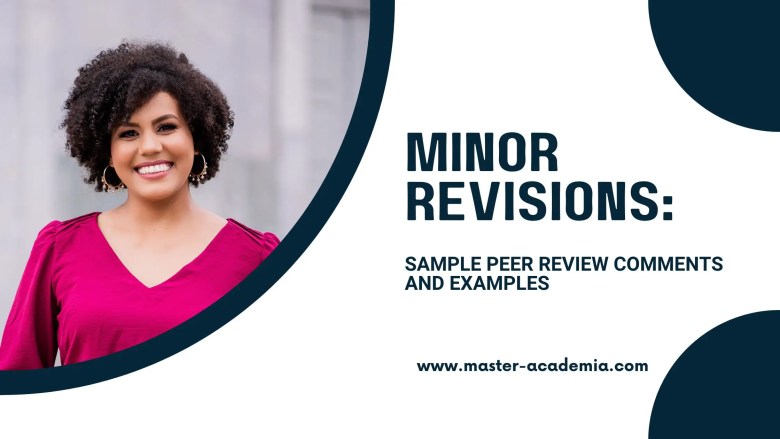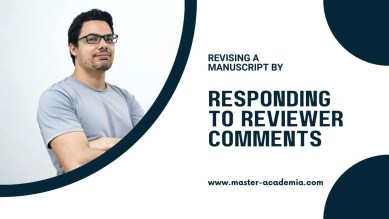
‘Minor revisions’ means that a manuscript only has to undergo small changes and improvements before it can be published in an academic journal. If you review a manuscript and struggle to formulate your feedback to reflect a ‘minor revisions’ verdict, look no further: get inspired by explanations, sample comments and examples!
Contents
When to decide on ‘minor revisions’
As a manuscript author, receiving ‘minor revisions’ is a huge reason to celebrate. It means that you are getting close to the final stages of the manuscript publication process!
Thus, evaluating a manuscript of someone else and deciding on ‘minor revisions’ requires careful consideration.
As a peer reviewer, you chose ‘minor revisions’ if a manuscript fulfils academic and disciplinary standards, and just needs some small adjustments before being publishable.
In the first round of academic peer review, ‘minor revisions’ is quite rare. Why? Because most manuscripts benefit from feedback and can be improved considerably. It does not happen very often that you peer-review a manuscript for the first time and think it is almost perfect.
If you are in doubt about whether you should go for ‘minor revisions’ or ‘major revisions‘, it can be smart to choose the latter. Only opt for ‘minor revisions’ if you are confident that the manuscript authors can implement your requested changes relatively easily.
Common reasons for a ‘minor revisions’ decision
There are six common reasons for a ‘minor revisions’ decision:
- The literature review can benefit from additional sources: As a reviewer with expertise on the topic of the manuscript, you may be aware of a recent publication or discussion that the authors do not include yet.
- The relevance and originality of the research are not underscored: Some manuscript authors are too humble, which results in a weak reflection on their research’s originality and relevance. Of course, you don’t want authors to be arrogant. But if a paper makes a valuable contribution (for instance by providing a unique theoretical framework or employing an original methodology), it should be highlighted.
- Figures, tables, or legends need fixing: Many manuscripts need minor fixes, for instance, to better illustrate data, include additional information, or provide more detailed explanations in a legend. Figures and tables also need to meet the journal’s requirements in terms of size, colours, etcetera.
- Some unclear sentences or paragraphs: ‘Minor revisions’ involve very detailed feedback. This could be an unclear sentence, a paragraph that should be rewritten, or a missing definition of a key term.
- Minor structural improvements would benefit the paper: Minor restructuring means that manuscripts can be improved by relatively straightforward changes, such as dividing the analysis into several subsections to improve readability.
- Some language mistakes are present: Sometimes, final language editing is all that a manuscript needs to be publishable. Think of grammar mistakes and some odd formulations.
Sample peer review comments for a ‘major revisions’ verdict
“This is a well-written manuscript that only needs to undergo a few minor changes. First, …”
“The manuscript is based on impressive empirical evidence and makes an original contribution. Only minor revisions are needed before it can be published.”
“I thoroughly enjoyed reviewing this manuscript and only have some minor requests for revision.”
“The authors develop a unique theoretical framework, and I believe that they should highlight their originality much more.”
“The authors conduct very relevant research, but fail to emphasise the relevance in their introduction.”
“The authors draw on extensive empirical evidence. I believe that they can put forward their arguments much more confidently.”
“The authors adequately addressed my feedback from the first round of peer review. I only have some minor comments for final improvements.”
“To improve the readability of the paper, I suggest dividing the analysis into several subsections.”
“Figure 3 is difficult to read and should be adjusted.”
“Table 1 and 2 can be combined to create a better overview.”
“The abstract is too long and should be shortened.”
“I had difficulties understanding the first paragraph on page 5, and suggest that the authors reformulate and simplify it.”
“The manuscript contains an elaborate literature review, but definitions of the key concepts are needed in the introduction.”
“Throughout the manuscript, there are several language mistakes. Therefore, I recommend a professional round of language editing before the paper is published.”
“The paper should undergo professional language editing before it can be published.”
Reviewer comments ‘minor revisions’ example 1
| The paper discusses innovations in Australian wildfire management in relation to natural forest regeneration. The authors embed their research in extensive international literature and make a compelling argument to study innovations from an intercultural perspective. I thoroughly enjoyed reviewing this manuscript and only have some minor requests for revision. First, I was surprised that the authors do not refer to the recent publications of Cuplet et al. who discuss very similar relationships in California. I think it would be valuable to link and build on these scholars’ work in the manuscript. Second, I believe that the authors are too humble and can put forward their claims much more confidently. They draw on extensive empirical evidence and make a valuable contribution to the field. This can – and should – be highlighted much more! And lastly, in the discussion, the authors should link their empirical findings to the international literature. This will also help them to emphasise their original research contribution. |
Reviewer comments ‘minor revisions’ example 2
| The authors adequately addressed my feedback from the first round of peer review. They improved the literature review and fixed the inconsistencies in the analysis. I only have some minor comments on the reworked manuscript: – On page 4, multifunctional enzymes should be defined – The subtitle of section 4.2 is misleading – On page 7, paragraph 4, references are missing – Throughout the manuscript, there are several language mistakes. Therefore, I recommend a professional round of language editing before the paper is published. |




